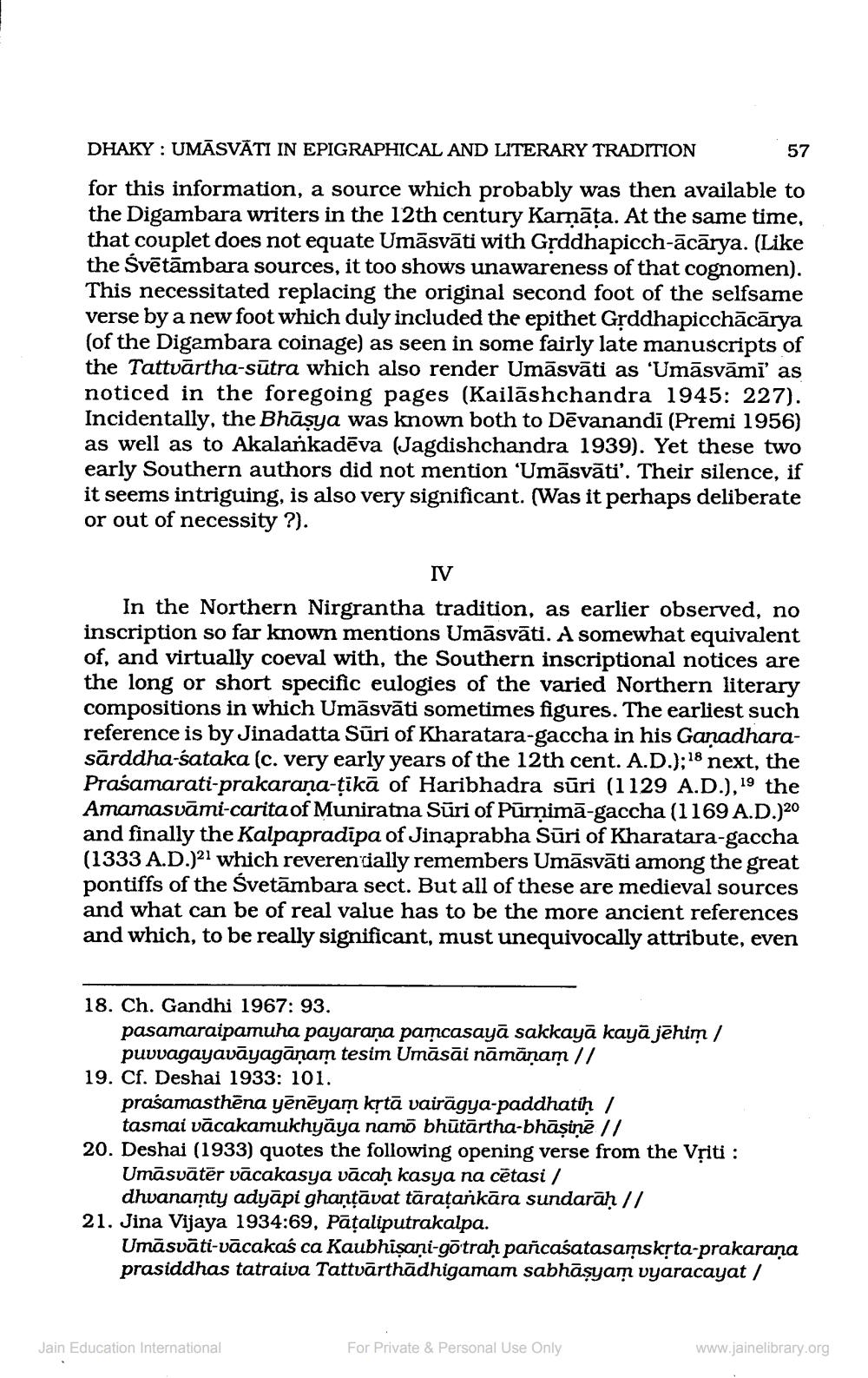________________
DHAKY : UMĀSVÄTI IN EPIGRAPHICAL AND LITERARY TRADITION
57 for this information, a source which probably was then available to the Digambara writers in the 12th century Karnata. At the same time, that couplet does not equate Umāsvāti with Grddhapicch-ācārya. (Like the Svētāmbara sources, it too shows unawareness of that cognomen). This necessitated replacing the original second foot of the selfsame verse by a new foot which duly included the epithet Grddhapicchācārya (of the Digambara coinage) as seen in some fairly late manuscripts of the Tattvārtha-sūtra which also render Umāsvāti as 'Umāsvāmi' as noticed in the foregoing pages (Kailāshchandra 1945: 227). Incidentally, the Bhāsya was known both to Dēvanandi (Premi 1956) as well as to Akalankadēva (Jagdishchandra 1939). Yet these two early Southern authors did not mention 'Umāsvāti'. Their silence, if it seems intriguing, is also very significant. (Was it perhaps deliberate or out of necessity ?).
IV
In the Northern Nirgrantha tradition, as earlier observed, no inscription so far known mentions Umāsvāti. A somewhat equivalent of, and virtually coeval with, the Southern inscriptional notices are the long or short specific eulogies of the varied Northern literary compositions in which Umāsvāti sometimes figures. The earliest such reference is by Jinadatta Sūri of Kharatara-gaccha in his Ganadharasārddha-sataka (c. very early years of the 12th cent. A.D.);18 next, the Praśamarati-prakarana-ţikā of Haribhadra sūri (1129 A.D.), 19 the Amamasvāmi-carita of Muniratna Sūri of Purnimā-gaccha (1169 A.D.)20 and finally the Kalpapradipa of Jinaprabha Sūri of Kharatara-gaccha (1333 A.D.)21 which reveren cially remembers Umāsvāti among the great pontiffs of the Svetambara sect. But all of these are medieval sources and what can be of real value has to be the more ancient references and which, to be really significant, must unequivocally attribute, even
18. Ch. Gandhi 1967: 93.
pasamaraipamuha payaraña pamcasayā sakkayā kayā jēhim /
puvvagayavāyagānam tesim Umāsāi nāmānam // 19. Cf. Deshai 1933: 101.
praśamasthēna yēnēyam kştā vairāgya-paddhatiņ /
tasmai vācakamukhyāya namo bhūtārtha-bhāşiņē // 20. Deshai (1933) quotes the following opening verse from the Vțiti :
Umāsvātër vācakasya vācaḥ kasya na cētasi /
dhvanamty adyāpi ghantāvat täratankāra sundarah // 21. Jina Vijaya 1934:69, Pataliputrakalpa.
Umāsvāti-vācakaś ca Kaubhisani-gotrah pañcaśatasamskrta-prakarana prasiddhas tatraiva Tattvārthadhigamam sabhāsyam vyaracayat /
Jain Education International
For Private & Personal Use Only
www.jainelibrary.org




